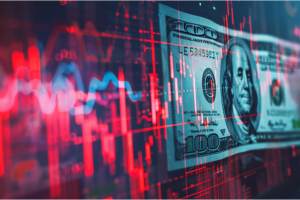
The ILA strike begins … the effects on inflation and automation … manufacturing keeps contracting … Japan elects a hawk … Bitcoin crashes through support … gold looks golden
There are major stories in the headlines. Today, let’s look at some of the biggest events likely impacting your wealth.
This morning, members of the International Longshoremen’s Association (ILA) walked off the job
As we’ve been covering in the Digest, ILA members went on strike, demanding a more lucrative labor contract from the United States Maritime Alliance.
JPMorgan estimates that the damage to the economy could be as high as $5 billion per day as cargo sits unloaded at docks, creating supply chain snarls that could impact holiday shopping.
We’ve been tracking this story from two main angles: inflation and automation.
As to inflation, here’s CNN Business:
The strike, which began at midnight, will stop the flow of a wide variety of goods over the docks of almost all cargo ports from Maine to Texas.
This includes bananas, European beer, wine and liquor, along with furniture, clothing, household goods and European autos, as well as parts needed to keep US factories operating and American workers in those plants on the job, among many other goods.
It could also stop US exports now flowing through those ports, hurting sales for American companies… Depending on the length of the strike, it could result in shortages of consumer and industrial goods, which could then lead to price hikes.
It could also mark a setback to the economy, which has shown signs of recovery from pandemic-induced supply chain disruptions that resulted in a spike in inflation.
Beyond higher prices for all sorts of retail goods, the associated risk is a complication of the Fed’s path for rate cuts.
If this strike drags on, leading to higher prices and an inflationary uptick, the Fed could face difficulty cutting rates as forecasted. The question for investors is whether Wall Street would sell off in response to that or look beyond the delay to a lower-rate environment.
As to automation, the ILA strike isn’t solely about more money
It’s also about protection from automation on the docks that replaces human workers.
Here’s The New York Times:
[Automation is at] the center of a contractual impasse now threatening to produce a debilitating strike starting Tuesday at ports on the East and Gulf Coasts of the United States.
Dock workers make no apologies for the wages they command — more than $200,000 a year in many cases, after factoring in overtime…
Their bosses are embracing automation in part as a way to reduce costs…
Most industry experts view automation as both inevitable and positive. The questions are: Who controls the technology, and will workers be cushioned against changes with training programs that prepare them for new opportunities?
As we noted in the Digest last week, “Strike or no strike, the trend toward robotics isn’t going to slow down.” Research and Markets reports that the global robotics market will see an eyewatering compound annual growth rate of 27.1% until 2032. That’s nearly 9X growth.
We’ll keep tracking this story, but the takeaway in your portfolio is simple: Go long automation and robotics stocks. Regardless of how this specific strike plays out, we know how this story ends – technology/automation might be slowed, but it won’t be stopped.
In the meantime, if the two parties can’t agree at the negotiating table, get ready for bare shelves at the grocery store.
Meanwhile, this morning we learned that manufacturing in September contracted for the sixth consecutive month
This morning, we received the latest Institute of Supply Management (ISM) Manufacturing Purchasing Managers Index Report. The Manufacturing PMI came in at 47.2, matching the August figure, as well as the forecast from economists.
Here’s Timothy Fiore, Chair of the ISM Business Survey Committee:
U.S. manufacturing activity contracted again in September, and at the same rate compared to last month. Demand continues to be weak, output declined, and inputs stayed accommodative.
Demand slowing was reflected by the (1) New Orders Index remaining in contraction territory, (2) New Export Orders Index contracting at a faster rate, (3) Backlog of Orders Index staying in strong contraction territory, and (4) Customers’ Inventories Index indicating customers’ inventories were “about right.”
That last point about “customers’ inventories being ‘about right’” is in jeopardy now that our nation’s east coast and Gulf ports are basically shut down.
No, we’re not in an official recession, but yes, our economy needs lower interest rates as many months of PMI data indicate. It’ll be interesting to see if the strike drags on, and how that could complicate the Fed’s interest rate policy.
Looking east, China isn’t the only Asian country with stock market drama
If you haven’t been watching, the Nikkei stock index in Japan has been on a rollercoaster ride in the wake of its recent election.
Last Friday, Japan elected Shigeru Ishiba as its next prime minister, narrowly defeating Sanae Takaichi.
This is noteworthy from an investment angle because Ishiba is a proponent of raising interest rates to help curb inflation, whereas Takaichi was more like former prime minister Shinzo Abe, who was committed to near-zero interest rates.
Now, remember, in late-July, the Bank of Japan’s modest rate hike caused a violent selloff as the yen carry trade exploded.
As we detailed here in the Digest, the yen carry trade refers to how global investors spent years borrowing in zero-interest rate yen, then investing that money elsewhere around the world (mostly in the U.S.) for higher returns. When the yen suddenly became more expensive, it exploded the trade for many investors, resulting in a sudden selloff.
Over the summer, Japanese officials tried to tamp down concerns, saying that there would be no more rate hikes this year, but Ishiba’s election suddenly casts that into doubt. Japanese investors sent the Nikkei down 5% in the wake of the election. It’s been bouncing around since – yesterday, it recovered nearly 2%.
Now, Ishiba tried to calm the markets over the weekend, saying that borrowing in Japan should remain relatively low-cost, but this comes after hawkish commentary a day prior.
Here’s The New York Times:
In comments on Friday evening, Mr. Ishiba reiterated his belief that to bolster Japan’s economy, interest rate increases, rather than cuts, would be necessary to help bring down inflation and stimulate sluggish consumer spending.
We’ll be watching to see how this impacts the yen carry trade which some traders believe is only about halfway unwound at this point.
Switching to crypto, Bitcoin failed to hold a critical support level
To set the stage for what’s happening, let’s return to our Digest from last Tuesday in which we featured analysis from our crypto expert Luke Lango. He was waiting for one trigger to signal a green light to jump back into the crypto space:
We would like to see Bitcoin make a move above $64,000 – and stay above $64,000 – to confirm that technical legitimacy of this rebound rally.
If that happens, we will view that as a “buy signal” from the market. That would likely be good time to start buying more cryptos.
The $64,000 level is important because it corresponds with Bitcoin’s downward trend line since the summer.
Since last week, Bitcoin surged to more than $66,000. While we were encouraged, here was our take:
Even though we like seeing these gains, we’d feel better if Bitcoin slipped back to $64,000 and used it as a springboard for a fresh leg higher.
Doing so would mean the grandaddy crypto had turned former resistance into support.
As I write Tuesday, Bitcoin has lost this key level. As you can see below, we’ve fallen beneath $64,000 and are now trading at roughly $62,000.

Now, this doesn’t mean Bitcoin can’t U-turn and reverse higher in the coming days. But this is a noteworthy technical loss that suggests more weakness is on the way. Current momentum suggests we could see Bitcoin potentially having to retest $54,000 for a third time.
Despite this disappointing possibility, bulls will enjoy the following chart. It shows Bitcoin from an historic “seasonality” perspective. It’s self-explanatory.

Finally, though gold has been setting new all-time highs in recent weeks, bet on even higher prices to come
There are plenty of reasons for this, but I’ll draw your attention to just one based on a headline yesterday from The Wall Street Journal:
Americans Are More Reliant Than Ever on Government Aid
Two weeks ago in the Digest, we looked at the issue of demographics and the coming impact on Social Security, national debt, taxes, healthcare, and the investment markets.
Here’s a quick recap:
Our nation is getting old.
The problem is that much our federal government’s financial systems run as a Ponzi scheme. The young pay for the elderly.
Now, this isn’t a problem in a thriving population where there’s significant household formation, families have loads of children, and the up-and-coming generations outnumber the older generations. But that’s no longer our reality…
Americans are no longer reproducing at the same rate as in past decades. Worse, we’re not even reproducing at a rate that sustains our population…
The two biggest line items on our government’s budget are healthcare and Social Security…
In 1960, the ratio of workers to Social Security beneficiaries was 5.1-to-1. By 2020, that figure had crashed to 2.6-to-1, and it continues falling rapidly.
We have two options…
One, move the retirement age higher and/or reduce Social Security payouts…
Or two, fire up the printing presses, pay retirees their Social Security benefits in nominal dollars, ignoring that the inflation-adjusted buying power of those nominal dollars has been taken out back and shot.
[Because our politicians will paper over this problem] get ready for dollar debasement on a scale we’ve never seen before over the coming decade…Among our investment action steps was to buy gold (as well as top-tier healthcare providers, healthcare REITs, and companies that service the needs of our elderly population).
With that background, here’s the WSJ:
Americans’ reliance on government support is soaring, driven by programs such as Social Security, Medicare and Medicaid…
The big reasons for this dramatic growth: A much larger share of Americans are seniors, and their healthcare costs have risen…
This spending accounts for a big and growing share of the national debt. But this year’s presidential candidates, Democrat Kamala Harris and Republican Donald Trump, have said little about reining it in. In fact, both have offered plans that would add to the costs.
To prevent this Digest from running too long, I’ll jump to the bottom line…
More of our elderly requiring more assistance from our government means more debt spending. Our government has no way out of its financial mess other than through printing more money.
Yes, gold is at all-time highs. And, yes, it could (and should) correct to remove some froth, but you must own gold as we head into an era of 100%+ debt-to-GDP on a permanent basis.
This won’t end well for the dollar. Make sure your wealth is hitched to assets that can float atop a flood of currency debasement. That flood is coming.
Have a good evening,
Jeff Remsburg





